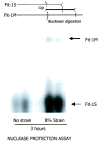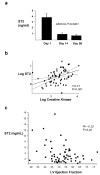Expression and regulation of ST2, an interleukin-1 receptor family member, in cardiomyocytes and myocardial infarction
- PMID: 12460879
- PMCID: PMC1460012
- DOI: 10.1161/01.cir.0000038705.69871.d9
Expression and regulation of ST2, an interleukin-1 receptor family member, in cardiomyocytes and myocardial infarction
Abstract
Background: We identified an interleukin-1 receptor family member, ST2, as a gene markedly induced by mechanical strain in cardiac myocytes and hypothesized that ST2 participates in the acute myocardial response to stress and injury.
Methods and results: ST2 mRNA was induced in cardiac myocytes by mechanical strain (4.7+/-0.9-fold) and interleukin-1beta (2.0+/-0.2-fold). Promoter analysis revealed that the proximal and not the distal promoter of ST2 is responsible for transcriptional activation in cardiac myocytes by strain and interleukin-1beta. In mice subjected to coronary artery ligation, serum ST2 was transiently increased compared with unoperated controls (20.8+/-4.4 versus 0.8+/-0.8 ng/mL, P<0.05). Soluble ST2 levels were increased in the serum of human patients (N=69) 1 day after myocardial infarction and correlated positively with creatine kinase (r=0.41, P<0.001) and negatively with ejection fraction (P=0.02).
Conclusions: These data identify ST2 release in response to myocardial infarction and suggest a role for this innate immune receptor in myocardial injury.
Figures





Similar articles
-
Interleukin-33 prevents apoptosis and improves survival after experimental myocardial infarction through ST2 signaling.Circ Heart Fail. 2009 Nov;2(6):684-91. doi: 10.1161/CIRCHEARTFAILURE.109.873240. Epub 2009 Sep 22. Circ Heart Fail. 2009. PMID: 19919994
-
Components of the interleukin-33/ST2 system are differentially expressed and regulated in human cardiac cells and in cells of the cardiac vasculature.J Mol Cell Cardiol. 2013 Jul;60:16-26. doi: 10.1016/j.yjmcc.2013.03.020. Epub 2013 Apr 6. J Mol Cell Cardiol. 2013. PMID: 23567618 Free PMC article.
-
Serum levels of the interleukin-1 receptor family member ST2 predict mortality and clinical outcome in acute myocardial infarction.Circulation. 2004 May 11;109(18):2186-90. doi: 10.1161/01.CIR.0000127958.21003.5A. Epub 2004 Apr 26. Circulation. 2004. PMID: 15117853
-
ST2: a novel remodeling biomarker in acute and chronic heart failure.Curr Heart Fail Rep. 2010 Mar;7(1):9-14. doi: 10.1007/s11897-010-0005-9. Curr Heart Fail Rep. 2010. PMID: 20425491 Review.
-
Roles of IL-33 in the Pathogenesis of Cardiac Disorders.Exp Biol Med (Maywood). 2023 Nov;248(22):2167-2174. doi: 10.1177/15353702231198075. Epub 2023 Oct 12. Exp Biol Med (Maywood). 2023. PMID: 37828753 Free PMC article. Review.
Cited by
-
Prognostic value of soluble ST2 and soluble LR11 on mortality and cardiovascular events in peritoneal dialysis patients.BMC Nephrol. 2020 Jun 15;21(1):228. doi: 10.1186/s12882-020-01886-7. BMC Nephrol. 2020. PMID: 32539731 Free PMC article.
-
Candidate-based proteomics in the search for biomarkers of cardiovascular disease.J Physiol. 2005 Feb 15;563(Pt 1):23-60. doi: 10.1113/jphysiol.2004.080473. Epub 2004 Dec 20. J Physiol. 2005. PMID: 15611012 Free PMC article. Review.
-
Novel Biomarkers in Heart Failure Beyond Natriuretic Peptides - The Case for Soluble ST2.Eur Cardiol. 2015 Jul;10(1):37-41. doi: 10.15420/ecr.2015.10.01.37. Eur Cardiol. 2015. PMID: 30310421 Free PMC article. Review.
-
Increased levels of sST2 in patients with mitral annulus disjunction and ventricular arrhythmias.Open Heart. 2019 Apr 28;6(1):e001016. doi: 10.1136/openhrt-2019-001016. eCollection 2019. Open Heart. 2019. PMID: 31168386 Free PMC article.
-
Looking into the Kinetics of NT-proBNP and sST2 Changes in Patients with Heart Failure Treated with Sacubitril/Valsartan: A Hint to Different Therapeutic Pathways.Drugs R D. 2023 Dec;23(4):397-402. doi: 10.1007/s40268-023-00438-2. Epub 2023 Sep 13. Drugs R D. 2023. PMID: 37702906 Free PMC article.
References
-
- Iwahana H, Yanagisawa K, Ito-Kosaka A, et al. Different promoter usage and multiple transcription initiation sites of the interleukin-1 receptor-related human ST2 gene in UT-7 and TM12 cells. Eur J Biochem. 1999;264:397–406. - PubMed
-
- Tominaga S. A putative protein of a growth specific cDNA from BALB/c-3T3 cells is highly similar to the extracellular portion of mouse interleukin-1 receptor. FEBS Lett. 1989;258:301–304. - PubMed
Publication types
MeSH terms
Substances
Grants and funding
LinkOut - more resources
Full Text Sources
Other Literature Sources
Medical

